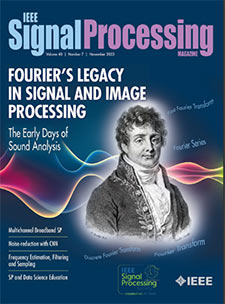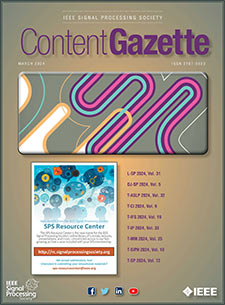- Our Story
- Publications & Resources
- Publications & Resources
- Publications
- IEEE Signal Processing Magazine
- IEEE Journal of Selected Topics in Signal Processing
- IEEE Signal Processing Letters
- IEEE/ACM Transactions on Audio Speech and Language Processing
- IEEE Transactions on Computational Imaging
- IEEE Transactions on Image Processing
- IEEE Transactions on Information Forensics and Security
- IEEE Transactions on Multimedia
- IEEE Transactions on Signal and Information Processing over Networks
- IEEE Transactions on Signal Processing
- IEEE TCI
- IEEE TSIPN
- Data & Challenges
- Submit Manuscript
- Guidelines
- Information for Authors
- Special Issue Deadlines
- Overview Articles
- Top Accessed Articles
- SPS Newsletter
- SigPort
- SPS Resource Center
- Publications Feedback
- Publications FAQ
- Blog
- News
- Dataset Papers
- Conferences & Events
- Community & Involvement
- Professional Development
- For Volunteers
- Information for Authors-OJSP
-
Home
Conferences14 April 2025 to 17 April 2025Conferences Events IEEE JSTSP Article IEEE Signal Processing Magazine IEEE TIFS Article IEEE TMM Article IEEE TSP Article Jobs in Signal Processing Lectures Machine Learning Seasonal Schools Signal Processing News SPM Article SPS Distinguished Lectures SPS Newsletter Article SPS Webinar SPS Webinars SPS Webinar Series Webinar webinars
-
Our Story
What is Signal Processing?

The technology we use, and even rely on, in our everyday lives –computers, radios, video, cell phones – is enabled by signal processing. Learn More » -
Publications & Resources
-
SPS Resources
- Signal Processing Magazine The premier publication of the society.
- SPS Newsletter Monthly updates in Signal Processing
- SPS Resource Center Online library of tutorials, lectures, and presentations.
- SigPort Online repository for reports, papers, and more.
- SPS Feed The latest news, events, and more from the world of Signal Processing.
-
SPS Resources
-
Conferences & Events
-
Community & Involvement
-
Membership
- Join SPS The IEEE Signal Processing Magazine, Conference, Discounts, Awards, Collaborations, and more!
- Chapter Locator Find your local chapter and connect with fellow industry professionals, academics and students
- Women in Signal Processing Networking and engagement opportunities for women across signal processing disciplines
- Students Scholarships, conference discounts, travel grants, SP Cup, VIP Cup, 5-MICC
- Young Professionals Career development opportunities, networking
- Get Involved
-
Technical Committees
- Applied Signal Processing Systems
- Audio and Acoustic Signal Processing
- Bio Imaging and Signal Processing
- Computational Imaging
- Image Video and Multidimensional Signal Processing
- Information Forensics and Security
- Machine Learning for Signal Processing
- Multimedia Signal Processing
- Sensor Array and Multichannel
- Signal Processing for Communication and Networking
- Signal Processing Theory and Methods
- Speech and Language Processing
- Technical Working Groups
- More TC Resources
-
Membership
-
Professional Development
-
Professional Development
- Mentoring Experiences for Underrepresented Young Researchers (ME-UYR)
- Micro Mentoring Experience Program (MiME)
- Distinguished Lecturer Program
- Distinguished Lecturers
- Distinguished Lecturer Nominations
- Past Lecturers
- Distinguished Industry Speaker Program
- Distinguished Industry Speakers
- Distinguished Industry Speaker Nominations
- Industry Resources
- IEEE Training Materials
- Jobs in Signal Processing: IEEE Job Site
-
Career Resources
- SPS Education Program Educational content in signal processing and related fields.
- Distinguished Lecturer Program Chapters have access to educators and authors in the fields of Signal Processing
- PROGRESS Initiative Promoting diversity in the field of signal processing.
- Job Opportunities Signal Processing and Technical Committee specific job opportunities
- Job Submission Form Employers may submit opportunities in the area of Signal Processing.
-
Professional Development
-
For Volunteers
-
For Board & Committee Members
- Board Agenda/Minutes* Agendas, minutes and supporting documentation for Board and Committee Members
- SPS Directory* Directory of volunteers, society and division directory for Board and Committee Members.
- Membership Development Reports* Insight into the Society’s month-over-month and year-over-year growths and declines for Board and Committee Members
-
For Board & Committee Members
Popular Pages
Today's:
- Submit a Manuscript
- Information for Authors
- (MLSP 2024) 2024 IEEE International Workshop on Machine Learning for Signal Processing
- SPS Scholarship Program
- IEEE/ACM Transactions on Audio Speech and Language Processing
- (SLT 2024) 2024 IEEE Spoken Language Technology Workshop
- IEEE Transactions on Image Processing
- IEEE Transactions on Multimedia
- IEEE Signal Processing Letters
- Information for Authors-SPL
- (ACSSC 2024) 2024 Asilomar Conference on Signals, Systems, and Computers
- Conferences & Events
- IEEE Transactions on Signal Processing
- (SAM 2024) 2024 IEEE 13th Sensor Array and Multichannel Signal Processing Workshop
- Governance Documents
All time:
- Information for Authors
- Submit a Manuscript
- IEEE Transactions on Image Processing
- 404 Page
- IEEE/ACM Transactions on Audio Speech and Language Processing
- IEEE Transactions on Information Forensics and Security
- IEEE Transactions on Multimedia
- IEEE Signal Processing Letters
- IEEE Transactions on Signal Processing
- Conferences & Events
- IEEE Journal of Selected Topics in Signal Processing
- Information for Authors-SPL
- Conference Call for Papers
- Signal Processing 101
- IEEE Signal Processing Magazine
Last viewed:
- 5 Free e-books for machine learning mastery
- Information for Authors
- IEEE Transactions on Signal Processing
- Guidelines for Reviewers
- Inside Signal Processing Newsletter
- (MLSP 2024) 2024 IEEE International Workshop on Machine Learning for Signal Processing
- Membership
- (MLSP 2023) 2023 IEEE International Workshop on Machine Learning for Signal Processing
- Feedback
- IVMSP TC Home
- SPCOM TC Home
- SPTM TC Home
- Signal Processing Cup
- AASP TC Home
- MLSP TC Home
Zhu, Yu (West Virginia University), “Multi-Modality Human Action Recognition” (2016)
You are here
Newsletter Menu
Newsletter Categories
Top Reasons to Join SPS Today!
1. IEEE Signal Processing Magazine
2. Signal Processing Digital Library*
3. Inside Signal Processing Newsletter
4. SPS Resource Center
5. Career advancement & recognition
6. Discounts on conferences and publications
7. Professional networking
8. Communities for students, young professionals, and women
9. Volunteer opportunities
10. Coming soon! PDH/CEU credits
Click here to learn more.
News and Resources for Members of the IEEE Signal Processing Society
Zhu, Yu (West Virginia University), “Multi-Modality Human Action Recognition” (2016)
Zhu, Yu (West Virginia University), “Multi-Modality Human Action Recognition” (2016) Advisor: Guo, Guodong
Human action recognition is very useful in many applications in various areas, e.g. video surveillance, HCI (Human computer interaction), video retrieval, gaming and security. Recently, human action recognition becomes an active research topic in computer vision and pattern recognition. A number of action recognition approaches have been proposed. However, most of the approaches are designed on the RGB images sequences, where the action data was collected by RGB/intensity camera. Thus the recognition performance is usually related to various occlusion, background, and lighting conditions of the image sequences. If more information can be provided along with the image sequences, more data sources other than the RGB video can be utilized, human actions could be better represented and recognized by the designed computer vision system.
In this dissertation, the multi-modality human action recognition is studied. On one hand, the authors introduce the study of multi-spectral action recognition, which involves the information from different spectrum beyond visible, e.g. infrared and near infrared. Action recognition in individual spectra is explored and new methods are proposed. Then the cross-spectral action recognition is also investigated and novel approaches are proposed in their work. On the other hand, since the depth imaging technology has made a significant progress recently, where depth information can be captured simultaneously with the RGB videos. The depth-based human action recognition is also investigated. The author first proposes a method combining different type of depth data to recognize human actions. Then a thorough evaluation is conducted on spatiotemporal interest point (STIP) based features for depth-based action recognition. Finally, the author advocates the study of fusing different features for depth-based action analysis. Moreover, human depression recognition is studied by combining facial appearance model as well as facial dynamic model.
Open Calls
News & Announcements
- GlobalSIP 2016: Call for Participation
- Featured News Around IEEE: IEEE Smart Grid Newsletter
- IEEE-USA Offers Free e-Books to Members in August and September
- IEEE Women in Engineering News: Leadership Summits and Events
- IEEE Maker Project Competition: Deadline 17 September
- News from IEEE Educational Activities: New Courses Available on IEEEx.org, Publications from Standards Education and IEEE-HKN
- MGA Financial Reporting Deadline Changed to Last Day of February
- Call for Proposals: IEEE Humanitarian Activities Committee Project Funding in 2016: Deadline 15 September
- Invite Members in your Section to Attend an Orientation Webinar or New Ignite Information Session
- Recognize Outstanding Volunteers: Call for MGA Awards Nominations: Deadline 15 October
- Get Involved in IEEE Future Directions Initiatives
- Announcing the New vTools.Events and Updates to vTools.eNotice
- Advance your Career with Mentoring and Employment Opportunities in IEEE Collabratec
- Contests in Signal Processing and Machine Learning
- Upcoming Distinguished Lectures
- Signal Processing Conferences
Society News
Education & Resources
Initiatives & Trends
Publications News
SPS on Twitter
- DEADLINE EXTENDED: The 2023 IEEE International Workshop on Machine Learning for Signal Processing is now accepting… https://t.co/NLH2u19a3y
- ONE MONTH OUT! We are celebrating the inaugural SPS Day on 2 June, honoring the date the Society was established in… https://t.co/V6Z3wKGK1O
- The new SPS Scholarship Program welcomes applications from students interested in pursuing signal processing educat… https://t.co/0aYPMDSWDj
- CALL FOR PAPERS: The IEEE Journal of Selected Topics in Signal Processing is now seeking submissions for a Special… https://t.co/NPCGrSjQbh
- Test your knowledge of signal processing history with our April trivia! Our 75th anniversary celebration continues:… https://t.co/4xal7voFER
Home | Sitemap | Contact | Accessibility | Nondiscrimination Policy | IEEE Ethics Reporting | IEEE Privacy Policy | Terms | Feedback
© Copyright 2024 IEEE – All rights reserved. Use of this website signifies your agreement to the IEEE Terms and Conditions.
A not-for-profit organization, IEEE is the world's largest technical professional organization dedicated to advancing technology for the benefit of humanity.







